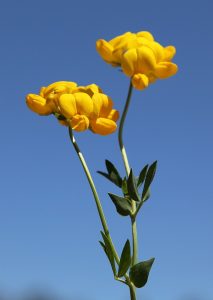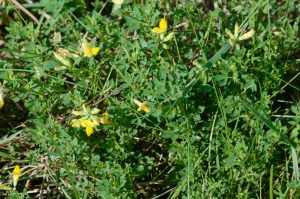Birdsfoot Treefoil Best Managed in October

Birdsfoot trefoil (Lotus corniculatus) is a low-growing, perennial broadleaf plant native to Eurasia and North Africa. It was introduced into the United States for erosion control and livestock forage and is still sold commercially. Birdsfoot trefoil is invasive in Wisconsin. Birdsfoot trefoil is found along roadsides, and in waste areas, fields, prairies, wildlife openings, and open disturbed areas. It tolerates a variety of soil types including dry, moist, hardpan or droughty soils.

Identification
A recent edition of the TechLine Invasive Plant News provides the following description of Birdsfoot trefoil. [It] “is in the legume family and produces stems up to two feet in length. Leaves are alternate and compound with five oval to linear leaflets. The plant flowers from May to August, when clusters of yellow, pea-like flowers develop. Fruits are pods that occur in head-like clusters with each pod containing up to 49 seeds.” It has a taproot that can reach three feet deep. There are also secondary roots, rhizomes, and modified stems (stolons) near the soil surface.
Concern
Birdsfoot trefoil outcompetes native prairie and savannah plants because of its dense root system, long growing season and multiple ways of spreading. It reproduces by seeds, and spreads laterally by stolons and rhizomes. Because it is a legume, birdsfoot trefoil increases soil nitrogen unfavorable for native plants. It is especially invasive in new restoration sites.
Management
 Birdsfoot trefoil can be effectively controlled with Milestone® specialty herbicide at 5 to 7 fluid ounces per acre (fl oz/A). Field trials conducted by Dr. Mark Renz, University of Wisconsin found that Milestone at 7 fl oz/A provided good to excellent control in either June or October. It was significantly better than Transline® specialty herbicide at 1 pint per acre applied in June (Figure 1). Milestone applied at 5 fl oz/A was more effective when applied in October compared to June with similar level of control.
Birdsfoot trefoil can be effectively controlled with Milestone® specialty herbicide at 5 to 7 fluid ounces per acre (fl oz/A). Field trials conducted by Dr. Mark Renz, University of Wisconsin found that Milestone at 7 fl oz/A provided good to excellent control in either June or October. It was significantly better than Transline® specialty herbicide at 1 pint per acre applied in June (Figure 1). Milestone applied at 5 fl oz/A was more effective when applied in October compared to June with similar level of control.
Manually digging plants to remove all root fragments can control small infestations of birdsfoot trefoil. Frequent mowing at a height of two inches for several years may reduce seed production and spread, but will impact desirable vegetation. A predatory insect called trefoil seed chalcid (Bruchophagus kolobovae Fed.) is available but is not good enough to provide significant control. Burning increases seed germination allowing the plant to establish and spread rapidly in areas managed for native prairie.
UW Extension has a fact sheet that contains more information about chemical, as well as other management practices for birdsfoot trefoil.
